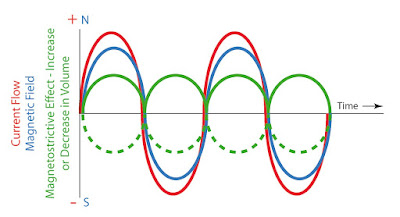Transformer noise is caused by a phenomenon which causes a piece of magnetic sheet steel to extend itself when magnetized. When the magnetization is taken away, it goes back to its original condition. This phenomenon is scientifically referred to as Magnetostriction.
A transformer is magnetically excited by an alternating voltage and current so that it becomes extended and contracted twice during a full cycle of magnetization. Transformer core is made up of thin CRGO steel strips which vibrate individually and in the process produce noise.
The magnetization of any given point on the sheet varies, so the extension and contraction is not uniform. A transformer core is made from many sheets of special steel to reduce losses and moderate the ensuing heating effect. The extensions and contractions are taking place erratically all over a sheet and each sheet is behaving erratically with respect to its neighbor, so you can see what a moving, writhing construction it is when excited. These extensions are miniscule proportionally and therefore not normally visible to the naked eye. However, they are sufficient to cause a vibration, and consequently noise. Applying voltage to a transformer produces a magnetic flux, or magnetic lines of force in the core. The degree of flux determines the amount of Magnetostriction and hence, the noise level.
Other sources may be due to discharges in loose joints, sharp edges, attraction and repulsion between windings due to currents in them causing them to vibrate around the core, heating of oil or air in the tank etc.
Why not reduce the noise in the core by reducing the amount of flux?
Transformer voltages are fixed by system requirements. The ratio of these voltages to the number of turns in the winding determines the amount of magnetization. This ratio of voltage to turns is determined mainly for economical soundness. Therefore the amount of flux at the normal voltage is fixed. This also fixes the level of noise and vibration. Also, increasing (or decreasing) magnetization does not affect the Magnetostriction equivalently. In technical terms the relationship is not linear.
Does the Transformer Noise Increases as the Load Increases?
There are forced between the conductors of winding when transformer is excited. This force will produce vibration and hence noise. The difference in noise at no load and full load at a constant magnetic flux density is not more than 1 to 2dB.
Thank you!


how to troubleshoot a transformer
Troubleshooting depends on the problem. If you specify the problem, one can suggest you the methodology.